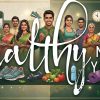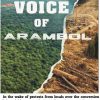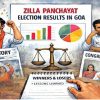Goa is abuzz with excitement as vintage bike and car owners, users, collectors and fans are decking […]

CLEARANCES FAST TRACKED
Cover Story, May 13- May 19 2017 May 13, 2017TOO CLOSE FOR COMFORT: The berth’s locations make it impossible for them to not affect Vasco and its residents. 1 – Berth numbers 5A, 6A operated by JSW since 2005. 7 million tonnes of coal per year. Wants to expand to 14 million tonnes; 2 – Berth number 7 operated by Adani Ports since 2014. 5 million tonnes of coal per year; 3 – Vedanta’s proposed berth – Berth numbers 8, 9 and barge berths nearby. Proposed coal handling: 7 million tonnes each year; 4 – Berths 10, 11 – Former coal handling berths. Berth 10’s coal handling shut down by high court order. Enclosed coal terminal was proposed on berth 11, but not followed through. Both berths now handle wood chips; 5 – Vasco fishing jetty where all fishing boats are anchored. Directly faces berths 10, 11 of MPT. When coal was handled, fishermen recall, “everything turned black”; 6 – Vasco da Gama main market, 7 – Sada hill – The entire area is a hill/plateau housing MPT’s headquarters and residential colony; 8 – Navigation channel – The 10 km long channel that MPT proposes to deepen by 5 metres to 20 metres. Ships sail along this to approach MPT berths 5A, 6A (operated by JSW), 7 (Adani), 8, 9 (Vedanta), 10 and 11 (MPT); 9 – Zuari ‘estuary’ – this is where the Zuari meets the Arabian Sea. The GCZMA had warned that dredging in this area could flush down river sediments, threatening riverside settlements like Chicalim and Sancoale
It has been reported that all the fast track clearances for the expansion of the coal handling facilities of MPT have come under pressure from the PMO
By Nihar Gokhale
IN 2012, when the Bombay High Court ordered the closure of two berths at Mormugao Port Trust (MPT) that handled the arrival of coal imports, the residents of Vasco in Goa felt a sense of relief. The sea breeze had been blowing coal dust from the port eastwards into the city. A resident, Deelip Mandrekar, had written a letter to the Chief Justice of the Bombay High Court in 2001. The letter became a petition, and 11 years later, the court upheld the case against the port.
The port trust closed down two berths – number 10 and number 11 – which were closest to the city. But the relief did not last long.
“I now see that this was a tactical move,” said TT Shreedharan, an advocate and activist who lives in Vasco. He was impleaded as the petitioner after Mandrekar passed away. Shreedharan pointed out the 2012 judgement of the Bombay High Court had asked the port to explore “enclosed” coal handling to reduce pollution.

PATRONAGE: Gautam Adani who is building the additional coal terminals enjoys the patronage of Prime Minister Narendra Modi
The idea had come from the port trust itself. In a feasibility report submitted to the high court in July 2010, it had outlined a plan to develop an enclosed terminal on berth 11, where four million tonnes of coal could be unloaded and stored in silos or domes. The cost of civil works was estimated at `425 crore.
In late 2011, the port trust told the court that the enclosed terminal could be built on berth 11 by October 2014, and that open air coal operations on berths 10 and 11, which are closest to the city, could be moved here. Convinced that this would “substantially redress” the grievance raised in the petition, the high court concluded the case in early 2012.
But the port did not build the enclosed terminal. It simply moved the open air operations to berths 5A and 6A further away from the city.
In the years since then, the volume of coal arriving at the port has risen rapidly. In 2014, the Adani group began operations on berth 7 with an annual coal handling capacity of five million tonnes. In 2016, it allotted berth 8 and 9 to Vedanta Resources for handling seven tonnes of coal annually on a public-private partnership.
Now, JSW group, which has operated berth 5A and 6A since 2005, wants to double its operations from seven million tonnes to 14 million tonnes of coal annually.
In the process, said Shreedharan, the high court’s order on limiting coal pollution emanating from the port has been rendered irrelevant.
The port chairman did not respond to Scroll.in’s queries. But reports commissioned by the port give insight into why the port wants to expand its coal handling capacity. With the expanding steel industry in Karnataka requiring more coal to fire its furnaces, the MPT wants to position itself as the port of choice for coal arrivals, since Goa is closer to the steel plants compared to the ports on India’s eastern coast.
In its endeavour, the port trust has received support from the Union Ministry of Shipping, as previously reported. But residents allege even government agencies meant to safeguard the environment have sided with the port.
The Goa State Pollution Control Board (GSPCB) is the state government agency that enforces environmental laws in the state. Industrial activity requires the board’s approval. It has the powers to shut down any activity that is causing air or water pollution beyond permissible limits.
For many years, the board kept a watch over the coal handling operations at Mormugao Port Trust.
In November 2012, Gammon India won a public-private partnership contract to develop an enclosed terminal at berth 11 to handle two million tonnes of coal. But in 2013, when the port trust sought permission from the GSPCB to open the terminal, the board raised concerns about increasing coal handling at the port. It pointed out that between JSW group and the Adani terminal, the port was already going to handle 12 million tonnes of coal. It asked the port trust to submit an impact assessment of coal handling at the existing berths, in order to get a permission for the new enclosed terminal. The port trust never submitted the study, and the enclosed terminal never came up.
In December 2015, it ordered Adani and JSW to cut down coal handling by 25 per cent each for one year, after pollution levels repeatedly breached safe levels, and ordered both firms and the port trust to deposit `10 lakh in bank guarantees.
Declining Interest
BUT the recent expansion at the port has paralleled a decline in the board’s interest in monitoring the port, say residents.
In March 2016, the chairman of the board, Jose Manuel Noronha, an educationist, was promoted as chairman of the Goa State Public Service Commission (GSPSC) and the chief secretary of Goa, RK Srivastava, was given additional charge of the board, even though it is an autonomous agency under statutory law.
In April 2016, the board announced that it is doing a month-long “comprehensive study” of air pollution from coal handling at Vasco. In its next meeting the board members resolved that “further action will be initiated based on the report on the comprehensive study being carried out.”
In the next meeting of the board held on June 29, the coal pollution report was left out of all follow-ups to the previous meeting. The report has disappeared since.
In August 2016, then state environment minister, Rajendra Arlekar, had briefly raised the issue in the state assembly. He said the air ambient quality monitoring stations installed in Vasco had shown dust pollution emanating from the port. “We have already asked them to reduce their handling by 25 per cent. The next step would be to reduce it by 50 per cent and if time comes, we will withdraw their consent to operate,” he said.
“We don’t want to play with life of people living in Vasco,” he added. “Those people have the right of clear air.”
But there was no follow-up action. Arlekar was defeated in the recent state assembly polls.
A senior officer of the GSPCB who did not want to be identified said that although the study had established high pollution levels, it had not carried out “source apportionment”, which would conclusively establish the exact quantum of pollution from each coal terminal. By then, the monsoon season had begun. “The rainfall settles dust particles, so you cannot take meaningful readings,” he said. “There was talk about giving the work to an IIT, but the subject never came up again.”
Invoking the PMO
THE other government agency whose green signal was required for the MPT’s expansion is the Goa Coastal Zone Management Authority (GCZMA), a panel of bureaucrats and experts whose clearance is needed for any activity within 500 metres of the coast.
When the port trust approached the coastal authority for its dredging project, it raised several red flags. Its field inspection report, dated August 2015, warned that the “sudden” deepening of the approach channel could cause “drastic morphological changes”. MPT is situated on the mouth of the Zuari river. The report explained that since the dredging would excavate 15 million cubic metres of seabed, massive amounts of river sediments could be flushed into it, eroding the river banks and threatening settlements along it.
The report also pointed out that the environment impact study conducted by Wapcos, the firm engaged by the port trust, did not assess these risks — it had not even prepared 3D images of the seabed, which would have helped know these risks better. The inspection report concluded that another agency be hired by the environment ministry at the centre to review the Wapcos study and give a second opinion.
Around this time, the MPT chairman, I Jeyakumar, visited the coastal authority members “for an informal chat over tea”, according to an official who spoke on the condition of anonymity.
“He kept on justifying the project, saying that Mormugao Port is competing with ports on the east coast,” the official said. “He was talking more like a businessman than the chief of a government port. But is the job of a government port to make profits?”
The official added that for this project, the port trust officials who interacted with the coastal authority frequently invoked the Prime Minister’s Office. “I told them one day, ‘why are you invoking the PMO all the time. This is a scientific issue, let’s tackle it from a scientific viewpoint’. They think that by saying PMO’s name, people will keep quiet,” the official said.
Environment Ministry
IN DECEMBER 2015, based on its inspection report, the coastal authority sent the port trust’s proposal to the environment ministry to conduct further studies. The ministry’s expert appraisal committee – another panel of experts that takes a final call on giving environment and coastal zone clearances – endorsed the authority’s view on the risks associated with the expansion. It recommended a clearance to the project, but on the condition that the coastal authority’s recommendations “shall be complied with”.
There is no evidence of the environment ministry seeking a second opinion, or a review of the Wapcos study. Instead, in two months, it granted the clearance to the port trust, making no mention of the concerns raised by the coastal authority, and bypassing the mandated public hearing.
The National Green Tribunal (NGT) subsequently quashed the clearance, while hearing a petition filed by two local fishermen cooperatives.
The port trust’s relentless pursuit of the expansion project has led many residents to give up hope of a fair process. Anil Satardekar, a resident of Vasco who was hospitalised for sudden breathlessness, did not think he would be able to attend any of the three public hearings organised by the GSPCB. “I have no faith in the pollution control board doing anything against MPT,” he said.
Courtesy: Scroll.in
RIGHT TO BREATHE CLEAN AIR
By Smita Nair
AS THE public hearing against expansion of coal handling berths at Goa’s Mormugao Port Trust began on the eighth, and concluding, day on Friday, Sherwyn Correia, 17, sought to take the podium at Tilak Maidan in Vasco. The Class XII student had to do some convincing to be allowed. The Additional Collector, who along with other representatives from the Collectorate office and Dr Mohan Girap, a scientist from GSPCB, was conducting the hearing, allowed Sherwyn only after he pleaded, “I will finish in five minutes. They are just six pages (long). Only the font (size of letters) looks big.”

YOUTH POWER: It was a young man from Class 12 who eloquently pleaded that in the interest of the future generations the GSPCB and the Mormugao municipality should not permit the expansion of the black monsters at MPT.
At around 10 am, Sherwyn was the day’s first speaker. By the time the session wound up around 9 pm, it became the longest public hearing Goa, and probably the country, has seen in recent times — and Sherwyn, who pleaded with the port authorities to “leave the children alone”, its youngest speaker and the event’s face.
GOA SPEAKS UP
SPEAKING against pollution raised by open handling of coal, the teen asked the port officials, “What have we done to you to deserve this? You are hampering our future; you are hampering our right to clean air and clean environment.”
Currently at a little over 12 million tons, Mormugao Port Trust in Vasco is planning to push for expansion of four berths and capital dredging as it envisages a four-fold expansion at over 50 million tons of coal import by 2030. The authorities aim to position Mormugao as the strategic choice for the growing steel industry in north Karnataka.
With iron ore mining in Goa taking a hit, coal imports now make for the port’s profit side of the balance sheet.
Starting April 26, with April 30 and May 1 being holidays, the public hearing saw housewives, fisherfolk, marine biologists, engineers, former mining employees, members of opposition political parties, priests, activists, lawyers, senior citizens and cancer patients, among others, come together to oppose what they call a plan to convert Goa into a coal corridor.
THREE PROJECTS
THE hearing took three projects separately: the first is the proposed terminal capacity expansion of two berths run by Jindal’s South West Port Limited to double coal imports to 14 million tonnes. The second is capital dredging of approach channel and inner sin for capsize vessels by Mormugao Port, and the third being another bunch on three berths being expanded for coal imports by Adani, and another by Vedanta and Adani through a public-private partnership.
Having decided to “speak up on behalf of the children of Vasco and Goa”, Sherwyn said, “Every day when I go to school and swipe my fingertip on my desk I get black coal dust. My school is located just across the road — if this is the amount of coal dust that settles on our desks, I cannot fathom the amount that each child has inhaled over the last several years.
“The rich and well-to-do moved out of Vasco to save themselves from pollution of coal-dust. But what about the thousands, particularly children, who cannot afford another home, and who continue to suffer? Will my children some day be able to enjoy the corals, the dolphins and the other invaluable marine life in Goa’s waters?”
Post-hearing, he said, “I heard all the elders speak for us. We are the future. Our fish is toxic, the water is getting ugly, and the air we breathe is no longer pure. My younger brother is six, and he is constantly suffering with cold, fever and with a running nose. I owe it to him.”
UNPRECEDENTED SCALE
ABIJIT Prabhudesai, a legal expert, said, “This is unprecedented for the manner and scale in which the hearing has shaped. This was denied to us before; none of us knew the expansion plans until [Union Road Transport and Highways and Shipping Minister] Nitin Gadkari came to inaugurate the capital dredging project in January 2016 — Gadkari had, in the first place, removed these projects outside of mandatory public hearings. The entire EIA (environmental impact assessment) report the port has put out is also misleading on various fronts. The officials seem to have no answers for any questions raised.”
Sherwyn’s father Savio, who pointed out discrepancies in all three EIA reports, said, “The public hearing’s biggest success was in the manner citizens were able to bring the EIA to scrutiny. The authorities have been stonewalling on these issues for more than two years, [but] here they had to come on record. [Besides,] these projects are being shown separately by the port and these hearings have proved that the cumulative impact from all three stands strong when looked together — the capital dredging is to allow bigger vessels to allow for bigger tonnage of coal imports. The whole plan of expansion of highways is being done only to shape Goa as a coal corridor, and the hearing was in some way able to expose that.”
Representing the fisherfolk, Olencio Simons said, “The large amount of contaminated water discharged into the sea after being used by the project proponents for dust suppression has resulted in dark patches in the sea, killing the flora and fauna.”
Dr Mohan Girap of the GSPCB said, “People were very responsive. Our job is to ensure they are satisfied with the hearing. We are now recording their minutes. This will be forwarded to the MoEF (Ministry of Environment & Forests) to make changes in EIA reports.”














